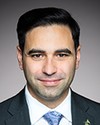No, I very much appreciate that.
Thank you.
Before discussing specific points in division 10, I want to point out that the bill does not explicitly affirm an exclusive federal jurisdiction over bank clients.
The proposed bill does not affect the provinces' capacity to enact regulations to protect consumers, and does not replace the existing rights consumers have under provincial legislation.
In addition to relying on the evidence collected in the two FCAC reports, the Department of Finance consulted extensively on the policy proposals that are reflected in the bill before you. We engaged 100 representatives from the provinces and territories, consumer groups, banks and external complaint bodies. Overall, the proposals were viewed as significantly improving protection for bank consumers.
The proposed amendments to the Bank Act and the Financial Consumer Agency of Canada focus around three themes: to require banks to have new internal bank practices to further strengthen outcomes for consumers; to provide the Financial Consumer Agency of Canada with additional tools to implement supervisory best practices; and to further empower and protect consumers.
If I may, I would like to just go through and explain how each of these themes are reflected in division 10.
First, division 10, as I said, indicates that there are new modifications required for internal bank practices. Perhaps I could start with clause 317. This new measure would require a bank to designate a committee of its board of directors to oversee the bank's obligations to its customers. The committee would report annually to the commissioner of the FCAC on what the committee did in performing its duties. This measure is intended to ensure that the most senior management of the bank assumes responsibility for the protection of consumers in their customers' dealings with the bank.
Another measure is to be found in proposed section 627.06, and there are two related provisions that I will highlight: proposed sections 627.07 and 627.02. These new measures together would require banks to have policies and procedures to ensure that the products and services offered to a person are appropriate, having regard to the person's circumstances and financial needs. In addition, banks would be required to ensure that remuneration practices, including benefits, do not interfere with the ability of employees or agents to comply with the suitability procedures. As well, employees of the bank would need to be trained on the institution's procedures for complying with the consumer provisions. Taken together, these measures are intended to ensure that consumers receive the products and services that are right for them.
I would like to highlight another group of proposed sections: proposed sections 979.1 to 979.4. These measures, taken together, would require banks to establish a whistle-blowing program. The legislation would also protect employees from reprisal by their employers, whether they report on information on suspected wrongdoings through the bank's internal whistle-blowing program or report this information to an appropriate authority. Effective whistle-blowing programs can help to foster transparency, promote integrity and detect misconduct that would otherwise have gone unnoticed.
On the second theme, new tools for the Financial Consumer Agency of Canada, the legislation also, as indicated earlier, provides new tools so as to better align the agency with supervision best practices and promote compliance with the consumer protection framework.
I would highlight the change proposed by section 661.1. In this provision, the commissioner would have the power to direct a bank to take actions to remediate non-compliance by a bank with their legal obligations towards their customer under the consumer protection framework. There is a complementary provision in proposed section 627.997 and this power would extend to ordering restitution to consumers where a bank has collected charges improperly.
A second set of amendments are around subsection 19(1) of the Financial Consumer Agency Act of Canada. That is in clause 344. These proposed amendments to the Financial Consumer Agency of Canada Act would increase from $500,000 to $10 million per violation the maximum penalty that can be imposed on banks that are found by the commissioner to have breached their legal obligation under the framework.
There is a further complementary provision in clause 347, proposed subsection 31(1) of the FCAC Act, which would require the name of the bank that has been subject to a penalty to be publicly identified in the commissioner's decision.
Higher penalties and public naming of banks subject to penalties are intended to increase the incentives for banks to comply with the consumer provisions.
The Financial Consumer Agency of Canada Act would also be amended to add an “object” provision. Financial institutions governed by the act would be regulated by a Canadian government organization, in order to contribute to the financial protection of Canadian consumers, notably by strengthening financial literacy.
In addition, the objects of the FCAC would be modified to expressly include that the agency should strive to protect the rights and interests of consumers. That is in clause 338.
Finally, I'll highlight a couple of new measures that would be empowering to consumers.
First, banks would be required to offer consumers the opportunity to receive electronic alerts when their account reaches or exceeds a low-balance threshold on deposit products, or approaches or exceeds a limit on credit products. That's in clause 329, proposed section 627.13. The provision of timely information to consumers is intended to help them better manage the fees they pay.
As well, in proposed section 627.03, the legislation proposes new prohibitions on providing consumers with misleading information, and in proposed section 627.04, applying undue pressure or taking advantage of consumers under any circumstances.
I'll highlight a couple of other provisions.
There are a number of improvements made to the way banks handle complaints from consumers. While banks are expected to address complaints directly with consumers, safeguards are still required to ensure the process is fair and transparent. To this end, banks are already required in the current framework to be a member of an independent external complaint body that must provide its services free of charge and in both official languages.
The proposed legislation would bring improvements to the complaint-handling process. It is proposed that banks keep a record of all complaints, making this information available to the commissioner of the FCAC. That's in proposed sections 627.44 to 627.46. “Establish”—complaint handling—“procedures that are satisfactory to the Commissioner” is in proposed paragraph 627.43(1)(a). A prohibition on using misleading terms, including “ombudsman” to describe the banks' internal complaint handling procedures is in clause 329, proposed subsection 627.43(2).
With respect to improved external complaints bodies, new requirements are being proposed to increase the transparency of the complaint handling process. These include, in proposed paragraph 627.49(i), a requirement for external complaints bodies to publish a summary of each final recommendation regarding a complaint, including the reasons for the recommendation.
Again in proposed paragraphs section 627.49(j) and (k)—











